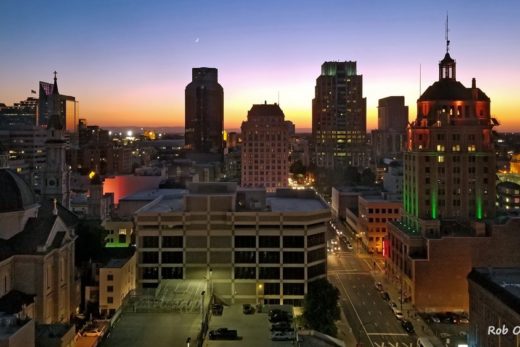
This project and this web site have necessarily highlighted the profound impacts of an accelerating technological revolution on the Golden State’s people and landscapes. From geospatial technologies to e-commerce distribution centers, new technologies continue to make radical changes in the ways and the locations where we carry out our daily activities.
The latest example erupted in 2018 and has impacted nearly every mobile person who leaves home in our more crowded urban environments. As if suddenly falling from the sky or spewing from some mysterious volcano of technology and engineering, e-scooters became popular and then ubiquitous in nearly all of our more densely packed urban landscapes by 2018. And though the eruption happened fastest and is most obvious in the state’s larger urban areas, they have impacted smaller cities (such as around Lake Tahoe) from near our northern to our southern borders. Like most new innovations, they caught regulators and traffic engineers by surprise, creating a Wild West atmosphere that jarred many off their feet or out of their cars.
These scooters can be discarded and relocated anywhere, they only require a smart phone and credit card and a dollar to get started, and they have allowed us to redefine and rethink how to make short efficient trips that could not be served by cars or public transportation. The companies Bird and then Lime quickly distributed them across urban landscapes and just as quickly became multi-billion-dollar businesses. As one might expect, a host of issues and controversies soon erupted over motorized scooters.
Pedestrian space rights advocates complained about reckless scooter riders on sidewalks and other paths at speeds up to 15 mph. As some scooters zipped around pedestrians unwilling to give up their limited spaces, other riders were crunched into already dense traffic lanes with too few safe pathways. Breaking state and local laws, most rode without helmets, many were obviously children without licenses, and some even rode with passengers. The results could have been predicted: a rash of accidents with serious injuries and some of the victims weren’t even riding the scooters. Others complained about the abandoned scooters cluttering pathways and neighborhoods as they waited for the next rider or the part-time employee that would take them home for a recharge.
Some cities responded with temporary bans until they figured out how to deal with this scooter chaos and the accompanying liabilities. But most cities searched for a regulatory environment that might encourage this clean and efficient form of short trip connective commuting without endangering the commuters. Here is an example where each community sought a general template that could then be redesigned to suit their specific needs and urban landscapes as they envision more sustainable transportation infrastructures.
The long-term health impacts range far beyond safety. Just as popular electric bikes allow us to go farther and faster without the exertion, so do the new e-scooters take pedestrians off their feet for a quicker commute at the expense of an invigorating walk. Several communities were also demanding that e-scooters be made equally accessible to low-income neighborhoods instead of only concentrating where the already well-to-do could conveniently zip farther ahead.
Depending on when and where you are reading this, you may already know whether this was just another short-term fad or another lasting technological revolution that took advantage of California’s mild weather to democratize transportation and make us wonder why someone didn’t think of it sooner. Here’s to a happy and safe commute.





